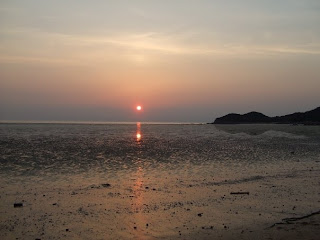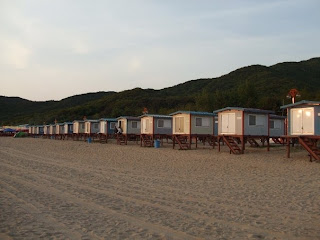The mid week Chuseok holiday this year is both a blessing and a curse. On one hand, most public schools and some hagwons are offering the Monday and/or Friday off, giving a generous 6-9 days of continuous vacation-more than enough to escape the country if you wish. For those who are stuck with Tuesday-Thursday, the options are a little less open.
The problem with Chuseok is that it is one of the two major holidays each year where the majority of Koreans travel back to their home towns, creating a mass exodus out of Seoul. Planes and trains are booked up weeks in advance, whilst buses and cars squat motionless on the highways with their drivers and passengers stewing inside. The hassles involved in leaving the country can put off even the most determined traveller so with that in mind, Get out of Seoul presents the rather contradictory ‘Chuseok Staycation’-your guide to exploring the capital this Korean thanksgiving.
Day One: The Great Outdoors
Ease yourself in to vacation mode with a day of hanging out in the autumn sunshine (hopefully). Seoul might not be a city that screams ‘nature’ or ‘wildlife’, but there are certainly some decent enough spots to check out. For a lazy day of picnicking, the riverside parks at Yeouido/Yeouinaru (Line 5) are a good bet. Eastern Seoul residents are well catered for with Olympic Park (Olympic Park Station, line 5, exit 3) and Seoul Forest (Ttukseom Station, line 2, exit 8), whilst those in the south west of the city have Boramae Park (Boramae Station, line 7, exit 2). Seoul Grand Park (line 4) and Children’s Grand Park (line 7) are other options.
 |
Yeouido Park
|
For those in the mood for something a little more active, Bukhansan National Park on the northern edge of Seoul has some great, rocky, hiking trails. Whilst locals who have stayed in Seoul over the holidays might well be out and about in this area, it’s likely to be a lot less crowded than a typical weekend in fall. Nearby Suraksan is another alternative. Further south, Gwanaksan is accessible from Seoul National University, Gwacheon and Gwanak stations. A wide variety of routes means there is something to suit everyone. For more details on hiking in these areas, see
here.
Continue the outdoor theme into the evening with some al fresco dining and drinking. Whilst many Korean restaurants are closed for some or all of Chuseok, it’s largely business as usual in foreigner friendly areas like Hongdae and Itaewon, although they may be a bit quieter than normal. The ever popular ‘Roofers’ in Itaewon is a decent spot for food and a few beers and although Hongdae’s playground will undoubtedly be a lot quieter than normal, it’s still fun to grab some drinks from the convenience store and people watch with friends.
Day Two: Playtime
Wednesday is the actual day of Chuseok, when Korean families gather together to celebrate and as such, this will be the day when the most things are closed. However, all of Seoul’s major theme parks-Seoul Land, Everland and Lotte World-remain open, along with the COEX aquarium. Whilst you certainly won’t have these places to yourself-it’s becoming more popular for families to take advantage of the time off and head to popular attractions-they should be a lot quieter than on the average weekend. Everland is the most extensive of the three, offering a zoo and the Carribean Bay water park (admission extra) and is located a short way outside of Seoul-buses take about 45 minutes from Gangnam station and traffic on this day shouldn’t be too bad. Seoul Land and Lotte World can be reached by subway from Seoul Grand Park station and Jamsil station respectively.
Again, many Korean-owned restaurants and bars will be closed on this day so it’s the ideal time to treat yourself to a taste of home. Itaewon has the widest variety of foreign restaurants, with Thai, Indian and Mexican places competing for your business. Areas like Hongdae and Gangnam should also have a number of decent options available.
Day Three: History and Culture
The final day of vacation is the perfect opportunity to finally check out a few of those cultural sights you’ve been meaning to get to for ages, if only the weekends didn’t disappear in a blur of much needed sleep and soju. Both Gyeongbukgung and Changdeokgung-Seoul’s two main palaces-are open, with Changdeokgung allowing independent visits on Thursday, unlike other days when you must join a group tour. The War Museum at Samgakji is also open, along with the Hanok village at the foot of Namsan. For those wanting to do some more modern sightseeing, both Namsan Tower and the 63 Building remain open also.
 |
| Gyeongbuk Palace |
 |
| Garden at Changgyeong Palace |
It’s likely that a least some of the traditional shops and stalls in Insadong, close to Gyeongbukgung, will be open on this day. In the evening, the excellent Korea House (Chungmuro station) offers a traditional Korean meal and performance in an old Hanok building-the perfect way to relax before heading back to work.
 If you’re one of the lucky ones who gets two weeks or more off for winter vacation, there’s no need to restrict yourself to travelling in Eastern Asia over the holidays. For something a little more adventurous, India is well worth considering-December and January see pleasant temperatures and dry weather in New Delhi and the surrounding area and with Air India starting a new service from Seoul via Hong Kong, you can be in the Indian capital within about 11 hours. For the first time visitor, India’s ‘Golden Triangle’ is ideal-consisting of the cities of New Delhi, Agra and Jaipur, it offers a bite sized introduction to the country which can be done comfortably in under two weeks’ leaving enough time for a relaxing stopover somewhere on the way home.
If you’re one of the lucky ones who gets two weeks or more off for winter vacation, there’s no need to restrict yourself to travelling in Eastern Asia over the holidays. For something a little more adventurous, India is well worth considering-December and January see pleasant temperatures and dry weather in New Delhi and the surrounding area and with Air India starting a new service from Seoul via Hong Kong, you can be in the Indian capital within about 11 hours. For the first time visitor, India’s ‘Golden Triangle’ is ideal-consisting of the cities of New Delhi, Agra and Jaipur, it offers a bite sized introduction to the country which can be done comfortably in under two weeks’ leaving enough time for a relaxing stopover somewhere on the way home.
 The first stop for many visitors in Delhi is the Red Fort, an imposing structure which seems to glow in the heat of the Indian sun. Once you walk through the covered bazaar crammed with jewellery and souvenir stalls, you emerge onto a wide expanse of lawn around which there are a number of other buildings, many in faded white marble which provides a dramatic contrast with the red walls of the exterior. Venturing further around the interior, a number of buildings have a slightly European flavour to them. The fort also boasts a sound and laser show at night, which is rather less tacky than it sounds and offers a good opportunity to see the structure in a different setting.
The first stop for many visitors in Delhi is the Red Fort, an imposing structure which seems to glow in the heat of the Indian sun. Once you walk through the covered bazaar crammed with jewellery and souvenir stalls, you emerge onto a wide expanse of lawn around which there are a number of other buildings, many in faded white marble which provides a dramatic contrast with the red walls of the exterior. Venturing further around the interior, a number of buildings have a slightly European flavour to them. The fort also boasts a sound and laser show at night, which is rather less tacky than it sounds and offers a good opportunity to see the structure in a different setting.























